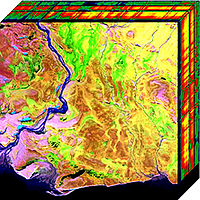
Photo from wikipedia
Preparation and characterization of some new thermochromic microcapsules with surface reactivity, material safety and their incorporation to cotton, and wool fabrics were performed in this work. Poly(methyl methacrylate‐co‐methacrylic acid) P(MMA‐co‐MAA)… Click to show full abstract
Preparation and characterization of some new thermochromic microcapsules with surface reactivity, material safety and their incorporation to cotton, and wool fabrics were performed in this work. Poly(methyl methacrylate‐co‐methacrylic acid) P(MMA‐co‐MAA) was the shell of microencapsulated thermochromic system (TS). The TS acting as a core substance consisted of n‐tetradecanol (TD) as solvent, crystal violet lactone (CVL) as a leuco dye and phenolphthalein (PP) as color developer. Particle photographs and average size distribution were evaluated using scanning electron microscopy (SEM) and particle size instruments, respectively. Microcapsules morphology was spherical and particle size average was 13.67 μm. Thermal treatment for thermophysical properties and degradation were performed by using differential scanning calorimetry (DSC) and thermogravimetry analysis (TGA). DSC and TGA results indicated that microcapsules absorbed 203.6 J/g of latent heat and had good thermal stability for textile applications. Meanwhile, microcapsules had thermo‐regulation property due to phase changing of the TD solvent, which was a solvent component of TS. Microencapsulation of TS into P(MMA‐co‐MAA) shell was proven by Fourier transform infrared (FTIR) spectroscopy. For thermally stimulated color change determination, UV‐visible spectroscopy analysis and photographs taken at 25°C and 50°C were used during temperature increase. Some cotton and wool fabrics imparted microcapsules were prepared by exhaustion technique. The heat absorbance capacities of fabrics during melting were measured as 68.2 J/g for cotton fabric and 72.5 J/g for wool fabric. From T‐history measurements, it was resulted that fabrics exhibited cooling and heating effect owing to the released or absorbed latent heat by TD. The color measurements based on CIELab system and photographs of fabrics taken at different temperatures showed that color of fabrics transformed from blue to colorless with increasing temperature. It was seen that the synthesized bifunctional thermochromic and energy storing microcapsules had great potential for production of textile materials, which served as reversible color change and thermal indicator.
Journal Title: International Journal of Energy Research
Year Published: 2020
Link to full text (if available)
Share on Social Media: Sign Up to like & get
recommendations!